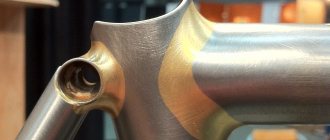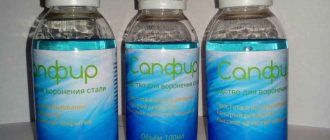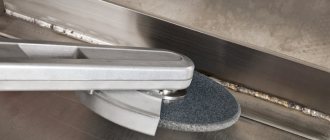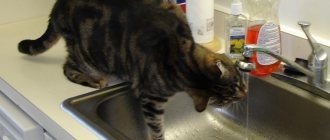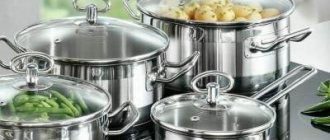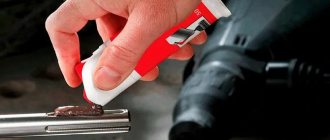Stainless steel kitchenware looks beautiful and is very practical. Stainless steel will last for many years, but only if the kitchen utensils are regularly cleaned to remove carbon deposits. There are many ways to clean a stainless steel pan from carbon deposits inside and outside so that it looks like new.
Cleaning products for stainless steel dishes
There are many ways to clean stainless surfaces. You can buy a special cleaning composition at a hardware store or use folk remedies.
Special washing and cleaning compounds
Today, consumers are offered a fairly large assortment of household chemicals that can effectively cope with a wide variety of stains on stainless household items. Experts advise choosing the most gentle and safe means.
The main advantages of special washing and cleaning compositions are time saving and efficiency. The disadvantage is that it is expensive.
Traditional methods
Here are instructions on how to quickly and easily clean stainless steel using baking soda:
- Wash the product with hot water.
- Dry with a towel.
- Cover the contaminated areas with baking soda and wait 1.5 - 2 hours. The soda can be slightly moistened.
- Wipe with a dry cloth or sponge. Rinse everything off with water and wipe dry again with a towel.
If soda does not give the desired result, then you can use the heating method. To do this, the dishes that need cleaning need to be filled with water, put on fire and brought to a boil.
After this, the product must be rearranged from the stove and 2 tablespoons of regular table salt added. After complete cooling, the stains will come off easily - just run a sponge over them.
Cleaning products
For cleaning, use only soft brushes and cloths, otherwise you may scratch the surface.
Most often, stainless steel products can be found in the kitchen and bathroom. Dishes, sinks, hoods, stoves, etc. are made from it. The combination of attractive appearance and practicality has made the material one of the most advanced on the market, but in the absence of proper care, its advantages will be invisible.
Stainless steel cleaner: store-bought products
Manufacturers of detergents and industrial products have not forgotten about stainless steel and have produced entire series to care for it. A wide range of polishes, foams, cleaning liquids, sprays, etc. are on sale. You can choose any at your discretion, the main thing is to strictly follow the attached instructions for use.
To remove dirt from the surface, you can use plain water, a soft sponge without abrasive particles, and regular dishwashing detergent.
You can use glass cleaner to remove fingerprints or water stains. Simply spray a small amount onto the surface and wipe thoroughly with a microfiber cloth. Rinse off residue with clean water and buff dry with a clean cloth. Excellent results are guaranteed.
How to wash stainless steel until it shines: folk remedies
Folk remedies are safer to use and are suitable even for allergy sufferers
It is not at all necessary to use industrial products for care; there are many ways to clean and polish stainless steel parts that were actively used decades ago. The most popular among them:
- To remove heavy stains, use a solution prepared from hot water and mustard powder. Using a soft sponge and this product remove almost all types of dirt. After using the mustard solution, remove the residue with clean water and wipe the surface dry with a clean rag.
- To remove white stains from water, it is recommended to use acids. Acetic table acid or lemon are ideal for these purposes. Steel products are wiped with a soft cloth soaked generously in vinegar or concentrated lemon juice. The residue is then washed off with water and the steel is wiped dry.
- If the stains are old and have already dried, then soda paste will come to the rescue. To prepare, mix a small amount of baking soda with water, then apply it pointwise to the stained area and leave for a while. After at least half an hour, dirt can be easily removed using a cleaning cloth.
- To clean a stainless steel pan in which food has burnt, you need to boil a small amount of water in it with 2 tsp. soda After this, burnt-on food remains can be easily removed using a sponge and dishwashing detergent.
- If stains or stains have formed on forks, spoons or knives, you need to wipe the surface with concentrated lemon juice, and then brush with toothpaste.
- To restore the products to their former shine, they are immersed in water in which the potatoes were boiled shortly before. The products are kept in the solution for at least 2 minutes. Afterwards, they are taken out and wiped dry with a soft rag, without first rinsing them under running water.
- To prevent the formation of white water marks on the steel surface in the future, they should be wiped off soon after use. You should not give them the opportunity to dry out on their own.
- You can polish the products with ordinary mineral or baby oil. It will create a protective film and add shine to the steel surface. Some housewives prefer to use car polish.
Cleaning the sink
Caring for a stainless steel sink is quite simple, but regular cleaning is not a 100% guarantee of getting rid of dirt. Contact with oxidizing agents may cause dark stains on the sink.
Suitable:
- baking soda;
- table vinegar;
- starch.
Some housewives even use regular bleach for these purposes. Use the funds as follows:
- Soda. The substance is poured onto the hard side of the sponge, moistened a little and wiped the problem areas. For hard-to-reach places, you can take an unnecessary toothbrush. Then everything is washed off with water and wiped in the usual way.
- Vinegar. It will help when the stainless steel begins to darken. Soak a sponge in vinegar and wipe the desired areas with it. Wait twenty minutes, then wash off the composition with water and detergent.
- Starch. To do this, use potato starch; a decoction will also work. Simply close the sink drain and pour the solution into it. Wait until the stains have time to disappear and wash the surface.
- Bleach. Apply the substance to a sponge, rub it on the desired area, and rinse with water. Just remember that whiteness can make the area lighter and stand out in appearance - this is the main disadvantage of this method.
Cleaning with improvised means
If you don’t have special products at home, you can make do with what’s at hand.
List of available tools:
- lemon acid;
- toothpaste;
- hydrogen peroxide;
- Activated carbon;
- soda, salt, vinegar, etc.
Mustard powder gained recognition when modern detergents did not yet exist. Dissolve a couple of tablespoons of mustard powder in hot water and wash the dishes in this solution. Then rinse with clean water. Mustard is an excellent remedy for disinfecting dishes and giving them shine.
Vinegar and citric acid are also a good way to remove plaque. Use a swab dipped in acid to wipe the surface of the stainless steel device and rinse with clean water. The kettle or pots will shine like new.
At worst, toothpaste will do for cleaning metal things. After all, it contains fluorine, which prevents the formation of plaque.
Video
To familiarize yourself with the nuances of cleaning stainless steel items, watch the following videos:
Young mother, wife and part-time freelancer. Being a lawyer by training, I am accustomed to collecting and providing the most complete and reliable information. Constantly improves in the professional field and strives for personal growth and development.
Found a mistake? Select the text with the mouse and click:
The dishwasher cleans more than just plates and cups. You can load it with plastic toys, glass lamp shades and even dirty vegetables, such as potatoes, but only without using detergents.
Stretch ceilings made of PVC film can withstand from 70 to 120 liters of water per 1 m2 of their area (depending on the size of the ceiling, the degree of its tension and the quality of the film). So you don’t have to worry about leaks from neighbors above.
There are special traps to combat moths. The sticky layer with which they are covered contains female pheromones that attract males. By sticking to the trap, they are eliminated from the reproduction process, which leads to a decrease in the moth population.
Threads made of gold and silver, which were used to embroider clothes in the old days, are called gimp. To obtain them, the metal wire was pulled for a long time with pliers to the required fineness. This is where the expression “to drag out the rigmarole” came from - “to do long, monotonous work” or “to delay the completion of a task.”
If your favorite things show the first signs of gestation in the form of untidy pellets, you can get rid of them using a special machine - a shaver. It quickly and effectively shaves off clumps of fabric fibers and returns things to their proper appearance.
The easiest way to remove scale and carbon deposits from the soleplate of the iron is with table salt. Pour a thick layer of salt onto the paper, heat the iron to maximum and run the iron over the salt bed several times, applying light pressure.
Before removing various stains from clothing, you need to find out how safe the selected solvent is for the fabric itself. It is applied in a small amount to an inconspicuous area of the item from the inside out for 5-10 minutes. If the material retains its structure and color, you can move on to stains.
Fresh lemon is not only suitable for tea: clean dirt from the surface of an acrylic bath by rubbing with half a cut citrus, or quickly wash the microwave by placing a container of water and lemon slices in it for 8-10 minutes at maximum power. The softened dirt can simply be wiped off with a sponge.
The habit of using an automatic washing machine “sparingly” can lead to the appearance of an unpleasant odor in it. Washing at temperatures below 60℃ and short rinses allow fungi and bacteria from dirty clothes to remain on internal surfaces and actively multiply.
Polishing with chemicals
This method is most often used when you need to clean small items. The main thing is that polishing takes little time and is very simple to do. Below are several recipes for solutions.
Recipe 1
It is important to maintain proportions here. Contains: 230 ml sulfuric acid, 70 ml hydrochloric acid, and 40 ml nitric acid
The rest is water.
For one liter of solution you need another 5 g of sodium chloride, 5 g of acid black dye and 10 grams of wood glue.
The resulting liquid must be heated to 70 degrees Celsius and the part must be lowered there. The product can be left in the solution for a maximum of half an hour.
Recipe 2
You will need orthophosphoric acid, it should make up 20-30 percent of the total volume. Hydrochloric acid (3-4%), nitric acid (4-5%), methyl orange (1%). The rest is water. The solution should be at room temperature, and keep the product in it for no longer than 10 minutes.
Recipe 3
The acid content is indicated per liter of solution. Acid orange dye - 25 g, sulfuric acid - 230 g, hydrochloric acid - 660 g. Heat the liquid to seventy degrees and keep the metal in it for no more than three minutes.
Polishing rules are given below:
- The metal must be thoroughly cleaned before polishing. Next, place the product in the solution. It should be remembered that only distilled water can be used here.
- During the procedure, the solution must be constantly stirred, only in this case the chemical reaction will take place 100%.
- When the required time has passed, the part is removed and washed well with running water. After this, the product must be well rubbed with a napkin soaked in polish.
After this treatment, all roughness is eliminated.
It is not enough to polish stainless steel correctly; it also needs to be cleaned regularly.
General cleaning recommendations
Stainless steel cookware should be cleaned as often as possible to avoid darkening of the metal, the appearance of persistent greasy stains or carbon deposits. For cleaning, use available home remedies or special household chemicals.
Steel objects should be washed with foam sponges, washcloths, and soft brushes. Metal scrapers and other abrasive tools leave unsightly scratches, so use them only as a last resort.
To clean stainless steel, do not use abrasives or hard brushes. They damage the protective layer, leave scratches, and spoil the aesthetic appearance of products.
Before cleaning, sort all items according to two characteristics: by purpose (pots, pans, cutlery) and by type of contamination (grease, carbon deposits on the outside, dust, etc.). This will allow you to choose the most suitable cleaning method, saving time and effort.
Pollution prevention
Professionals have compiled a whole list of preventive recommendations that will extend the service life. First of all, you should refrain from using hard sponges and brushes, they destroy the protective chrome coating. If you need to remove burnt food or other frozen dirt, you should apply a special product to it and leave it for a while, allowing the stain to become softer. Experts strongly advise soaking stains for at least half an hour, then the cleaning process will be faster and easier.
If you need to clean the stove, grill or grates, you must first remove all excess. This will not only reduce cleaning time, but also create more comfortable conditions for it. In addition, experts recommend removing dirt and grease from stainless steel surfaces as soon as possible.
And, perhaps, the last thing you need to know is that stainless steel does not react well to moisture, so after cleaning the product you need to wipe it dry.
Caring for stainless steel structures is not as difficult as it might seem at first glance. If you follow all the instructions from experts on how to clean a stainless steel smokehouse, you can significantly extend the service life of the products and maintain their attractiveness for many years.
Secrets of care
Caring for stainless steel cookware is easy. There are three rules that must be followed during operation.
Regular cleansing
After finishing cooking, do not delay in washing pots and saucepans. Dried traces of food on the walls are much more difficult to wash off than fresh ones.
Difficult stains need to be soaked. Scrub using special sponges and gels.
Delicate wash
It is better not to use cleaning products containing abrasive and aggressive substances. The use of soft gels extends the life of dishes.
Perfect dryness
Do not put a wet pan in the cupboard. After each wash, you need to wipe it dry with a towel. If you follow this rule, there will never be streaks on the bottom and walls.
Folk remedies for cleaning stainless steel
It is not necessary to use harsh chemicals to clean stainless steel; there are many ways to clean and polish stainless steel that our mothers and grandmothers used. Here are the most popular ones.
To clean contaminated steel surfaces, you can use hot water with the addition of mustard powder. Using a brush and the prepared solution, you can clean many types of dirt. After cleaning with mustard powder, all surfaces should be rinsed with clean water and wiped dry.
To remove white sediment from water from the surface of stainless steel, you can use acids. Vinegar or lemon are suitable for these purposes. You need to wipe steel items with a cloth soaked in vinegar or lemon juice and rinse with clean water.
If the dirt has dried, a paste of baking soda and a small amount of water will help you. Apply it to the stain and leave it for a while. After which the dirt can be easily washed off with a cleaning cloth.
Plastic
Lime deposits can form on plastic, like on any other surface. This is especially true for plastic pallets. How to effectively clean plastic?
To avoid scratching a soft plastic product, you should not rub it with hard (especially metal) brushes and abrasives. A delicate approach is required. And ordinary vinegar will help us again.
We take 9% table vinegar. Apply to plastic using a soft sponge or spray bottle. As usual, we apply pieces of cloth or napkins soaked in vinegar to particularly contaminated areas. You can pour vinegar into a plastic tray; the tray is usually not very deep, and vinegar is inexpensive - so we pour it to the brim and cover it with cellophane (so it doesn’t stink so much). Leave for about 20 minutes. And a soft sponge or napkin, carefully wipe off the softened plaque (if it has not completely dissolved by this time). Rinse with clean water and wipe dry. Instead of table vinegar, you can use a solution of citric acid - 25 g of acid per 1 glass of water.
If you know how to clean any surface from limescale and are not lazy, your plumbing will always delight you and your family with its cleanliness and beautiful appearance.
Recommendations for caring for bronze and stainless steel items
When cleaning bronze and stainless steel, it is necessary to provide for the possibility of preserving the renewed state. The fact is that after removing the plaque with reagents, an invisible oxidation reaction begins to occur in the upper layer, destroying the metal.
After cleaning, bronze products require protective surface treatment. For these purposes, compositions of natural origin based on natural wax are used.
As for stainless steel, to preserve its original appearance, experts do not recommend washing things in the dishwasher. For daily cleaning of food debris, it is better to use a regular sponge in combination with a suitable detergent. Do not use cleaning abrasives, sponges or metal scourers. Their use leads to the formation of scratches and loss of the characteristic shine of the dishes.
Useful tips
In addition to the techniques and methods discussed above, the following recommendations may also be useful:
- Tarnishing of bronze can be easily removed by applying pre-cooked peas and brought to a paste state to the surface. The liquid mixture must dry completely, after which the product is washed in boiling water and wiped with a damp cloth.
- You can restore the natural appearance of bronze objects with toothpaste applied to flannel or suede. After processing, rinse the item with water and dry.
- Ammonia and mustard powder can be used to clean bronze from plaque.
- Coffee grounds are used to restore the characteristic shine of stainless steel.
In conclusion, we note that the procedure for using these funds is similar to the methods discussed earlier
Please note that the listed methods and approaches for cleaning stainless steel and bronze are based on effective time-tested traditions
Loading …
Responsibility requires work to give the original appearance to expensive bronze art products. The technology requires restoring their characteristic shade. Only in this case will a bronze figurine or other object become a spectacular addition to the interior or shine at exhibitions.
How else to clean stainless steel items
- You can also clean stainless steel with a mixture made from soda and mustard powder, and for hard-to-reach places and small parts it is better to use a soft brush.
- There is another method for cleaning stainless steel - potatoes. Cut the raw vegetable in half and wipe the piece onto the dirty surface. After this procedure, the stainless steel will become shiny. You can boil utensils in potato broth. This manipulation will give the objects a good shine.
- Vinegar is also a good way to clean stainless steel; it is used to wipe objects, which are then rinsed in water and wiped.
- When dark spots appear on stainless steel, the same lemon juice will come to your aid. You just need to wipe the stainless steel with a woolen cloth soaked in this juice. This method perfectly removes plaque from the surface.
- Coffee grounds are a good way to clean stainless steel.
Of course, nowadays there are a huge number of cleaning foams, creams, and gels designed specifically for stainless steel, which can also effectively cope with dirt, deposits and stains on electric stoves, sinks and dishes. In addition, cutlery and other utensils can be safely put into the dishwasher using the maximum setting.
Stainless steel products do not require any special care, but sometimes you have to deal with stains that tend to appear on their surface. From this article you will learn how to clean stainless steel at home, what products should be used for this, and much more.
Preventative measures
To prevent a stainless steel sink from losing its original appearance, do not forget about preventive measures - they prevent the formation of stains on it. I will advise you a few simple steps:
- Minimum abrasives. Do not constantly clean the surface with powder substances containing abrasive particles. Firstly, they can cause minor scratches, and secondly, their price is much higher than conventional means at hand.
- Do not leave food residues in the sink. After washing dishes, always empty the sink of any leftover food. They provoke the formation of new stains that eat into the surface.
Do not leave dirty dishes in the sink overnight - this can cause unpleasant odors and stains.
- Do not use wire brushes. They may cause minor scratches.
- Regular polishing. To keep your sink shiny, treat it with vegetable or olive oil at least once every two weeks.
Traditional methods for removing plaque and stains from the sink
When a regular washing gel cannot cope with stains, you can use improvised means that you can always find at home or in the store. If you don't clean your sink daily, you'll end up dealing with dark stains, limescale, and greasy residue. Using folk recipes will help clean your sink and prevent serious contamination.
Removing black stains from a stainless steel sink
No matter how well the surface of the sink is cared for, over time the metal begins to darken and black spots appear on it. It's all about food oxidizing agents.
To clean the surface of the sink from blackness, you will need:
Soda and starch. Apply the mixture of the two components to a damp sponge and clean the darkened areas of the sink. At the end of the procedure, rinse everything thoroughly with water.
Household bleach
It easily copes with dark plaque, but you need to treat stainless steel with this composition with caution to avoid white spots. “Whiteness” will do, but dilute it with water before use.
Dentifrice
It can be applied to an unusable toothbrush and whitens hard-to-reach and ridged areas of the sink.
All components for recipes can be easily purchased at your local store, and creating the required solution will take 3-5 minutes.
Cleaning limescale on a sink
White plaque is formed due to daily contact of water with the surface. To prevent limescale, you need to ensure that the tap is sealed and wipe the sink dry after each use.
If plaque has already appeared, folk remedies will help:
- Vinegar. Dilute the acid with water one to one. The solution will not only remove plaque, but also add shine.
- Lemon acid. Fill a sink with warm water and add the contents of one sachet of citric acid. Leave the resulting mixture for 1-2 hours. Rub the problem areas with a nylon sponge, then drain the liquid and rinse the sink with water. A highly concentrated solution of citric acid can contribute to the appearance of dark spots.
- Soda. Sprinkle the surface of the sink and rub problem areas, rinse with water. Repeat the procedure several times, depending on the degree of contamination.
- Dry mustard. Rub the areas sprinkled with powder with a nylon washcloth, then rinse thoroughly. Mustard copes well with limescale and eliminates unpleasant odors from food waste.
- Paste for cleaning ovens. Apply to contaminated areas and treat with a soft washcloth, then rinse with running water.
Folk remedies are non-toxic and safe for the sink itself and for others. If there are small children in the family, such cleaners will not harm their health.
Removing greasy deposits from the sink
Cleaning gel for washing dishes helps to cope with this problem well. But if you don’t have this on hand, you can use laundry soap or make a mixture of soda and office glue yourself. The recipe is simple:
- Mix 5 liters of boiled water, 100 g of soda and 100 ml of glue. The components must be completely dissolved.
- Close the hole in the sink and fill it with the prepared solution.
- Wait for the liquid to cool and drain it.
- Remove grease and dirt. This will be easy because they will soften and move away from the walls.
The effective remedy is prepared in 5-7 minutes and does not require special skills. The result will be visible after the first use, and daily use of the solution will help protect the sink from greasy deposits.
Eliminating unpleasant odor from the sink
Cleaning the sink surface does not always help get rid of an unpleasant odor. It usually comes from food waste and can be felt straight from the drain. Household chemicals will help here. Sanfor, Mole and similar preparations will remove deposits on the walls, and with them the smell will disappear.
If the drain is made of plastic pipes, aggressive substances can damage the integrity of the structure. In this case, you can use folk remedies:
Salt. For 1 l. Warm water will require 5 tbsp. l. Pour the resulting solution into the hole in the sink, after 1-1.5 hours, rinse everything.
After the procedures have been completed, the unpleasant odor will disappear, as will all blockages that prevented the rapid passage of water through the drain.
If the pipes in the apartment are made of metal, household chemicals will deal with the blockage faster than traditional methods.
Types of burning
Two types of carbon deposits form on the surface of a stainless steel pan: inside and outside.
Carbon deposits appear inside the cookware if the food burns. There is carbon deposits on the outside of the pan if drops of fat and water splash across the surface of the metal. Gradually, the walls and bottom of the pan become covered with organic deposits, and if they are not removed in time, the deposits become thicker and denser.
Sometimes it is difficult to get rid of old carbon deposits. But if you approach this problem correctly, even many years of burnt marks can be removed practically without a trace. Proven folk recipes made from affordable and cheap products, as well as household chemicals, will help here.
How to clean stainless steel
Stainless steel household products are often found in modern kitchens: cutlery (spoons, forks, knives, pots), kitchen sink and stove
The question of their safety is relevant, and therefore we will pay close attention to methods of care and cleaning from oxides and stains
Traditional methods
Household products include:
- Baking soda;
- Activated carbon;
- Table vinegar;
- Citric acid or juice.
Apply dry substances by applying to areas with stains and leaving for 1-2 hours for soda, 15-20 minutes for activated carbon. When applied, the coal powder is moistened with a small amount of water, a reaction begins, and a slurry is formed. After treatment, items are wiped with a soft sponge and washed under running warm water.
Vinegar and citric acid are universal means that help cope with stains that appear on the surface of stainless steel. To process, take a clean flannel cloth, soak it in a little vinegar or lemon juice and rub the tarnished areas of the dishes. Upon completion of the procedure, rinse these areas with clean water and wipe dry.
Purchased chemicals
The range includes household chemicals that allow you to effectively deal with darkening and stains on the surface of stainless metal. When choosing, give preference to less aggressive chemicals to minimize harm from exposure.
The most common compositions include imported products from the brands “Amway”, “Magic Power”, “Dr. Beckmann” and others. Before use, heat the dishes to a certain temperature, apply the liquid composition and leave for the time specified in the instructions. Rinse off the product with a sponge under running water and wipe the stainless steel cookware dry.
INFORMATION!
The main advantage of household chemicals is saving time (traces of stains are removed quickly and for a long time). The disadvantage is the high cost of imported products.
Video recommendations
HOW TO CLEAN A POT, frying pan and other utensils from carbon deposits and grease EASILY? How to wash everything until it shines?
Watch this video on YouTube
What prevents steel from rusting
When chromium interacts with oxygen, a protective film is formed on the surface of stainless steel; it is this film that protects the alloy from exposure to aggressive environments.
The amount of chromium will determine the degree of corrosion resistance of steel.
For example, in the manufacture of refrigerators, an alloy with an average chromium content (10-17%) is used. But if the device is constantly in contact with water or is subjected to temperature loads, then an alloy with a high chromium content, up to 26%, is used. Such appliances include washing machines, dishwashers, sinks, hoods, cookers and kettles.
How to polish stainless steel to a mirror at home
Polishing stainless steel in a private workshop to a mirror finish is considered affordable. The processing time depends on the number of scratches on the surface, as well as the presence of metal oxidation. Chemical polishing is not recommended as it may be harmful to humans. To process your product with your own hands until it shines you need:
- Install a polishing wheel with fine abrasive on the grinding machine.
- Choose a polish for stainless steel without wax; it is recommended to use abrasive grains of a minimum size in the composition.
- Pour polish onto the circle.
- Bring the device to the left corner of the product.
- Apply power to the machine by pressing the start button.
- The device must be moved in a circular motion.
- After polishing, turn off the power, and then use a rag to remove the remaining polish by wiping away any roughness.
Compliance with stainless metal processing technology will help to obtain a surface without roughness up to class 14. At the same time, the metal acquires a mirror shine.
Polishing stainless steel, flat. Full version.
Preventive measures
It is necessary to prevent the formation of stains on stainless steel if possible. To do this, resort to the following prevention:
- Do not leave leftover food inside the sink. After washing the dishes, you need to remove all pieces of food.
- Abrasives. They provoke the appearance of scratches and are superior to improvised means, so you should not resort to them on a regular basis.
- Dirty dishes. You should wash it right away; you should make it a rule not to leave it in the sink overnight.
- Polishing. Once every two weeks, it is recommended to polish the sink with olive or vegetable oil - this will keep it shiny.
- Metal brushes. They may cause scratches on the surface.
Methods for polishing stainless steel
There are several technologies for polishing stainless steel, among which the most common are mechanical, chemical and their varieties. Mechanical is used to restore the mirror finish of stainless steel directly on site, as well as for workshop repairs and processing of small batches of products. When in-line processing of stainless steel parts at industrial enterprises, as a rule, the method of electropolishing in chemical solutions is used. You can bring stainless steel to a shine at home using methods and means available to everyone.
Mechanical polishing
After machining or rolling, longitudinal stripes and grooves remain on the surface of stainless steel products. These irregularities, in the best case, have a roughness class of 6–7, so grinding stainless steel to class 8–10 is a prerequisite for preparing for the polishing operation, since classes 11–14 correspond to this type of processing.
Mechanical polishing of stainless steel can be done manually, without the use of power tools or special devices. This treatment is most common in everyday life and for small volumes of repair and restoration work. The following types of production equipment are used in production plants for polishing stainless steel:
- hand-held electric and pneumatic tools;
- polishing machines;
- drum and vibration devices;
- magnetic abrasive installations.
The most common abrasive materials for polishing stainless steel are various liquid polishes, suspensions and pastes, which allow you to achieve the best results in terms of roughness. Most of them are based on technical oils, fats and substances such as paraffin and stearin, which have to be removed from the surface of the stainless steel using organic solvents.
Electrochemical method
ECP allows you to process any hard-to-reach cavities and complex shaped elements by removing the same layer of metal over the entire surface of the product. Installations that perform chemical electropolishing of stainless steel operate at an electrolyte temperature of 70÷90 °C and a current density of 0.3 to 0.5 A/cm². Solutions based on a mixture of inorganic acids are used as electrolytes. For this reason, ECP is sometimes confused with chemical etching of metals and even nitric acid is mentioned in articles about them, although the main components of the electrolyte for stainless steel are phosphoric and sulfuric acids.
Electrolytic plasma polishing
Another advantage of this technology is the low cost and environmental safety of the chemicals used to prepare electrolytes. In particular, when electrolyte-plasma polishing of stainless steel products, safe solutions of ammonium salts with a concentration of 3–6% are used.
